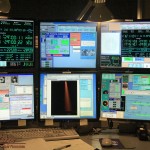Keck tracks every night with a custom, in-house database. These form a complete log of what occurred every night… The routine, the problems, the small disasters of operating a complex facility on top of a mountain. Reading these logs every morning is a ritual for many of the staff. A synopsis arrives in our e-mail each day, to be read on an iPad over breakfast, or as soon as you sit down at your desk.

Below is a typical night log from a quiet night. Reading through the logs each morning reveals much about the inner workings of the observatory. Who was working the night, the visiting astronomers and their subject of study. The logs also contain a number of statistics that are used to monitor the performance of the observatory.
Keck staff tracks all manner of time losses and inefficiencies. This night was typical, about nine hours of good dark time available for observation, of which six hours was spent “working”.
Three hours lost? To what? We use a very strict definition of science time, including only the time the instrument is on-target and collecting data. The various inefficiencies; the time spent moving the telescope, setting up the instrument for each new target, reading out the data, etc. are tracked. By keeping track of these time losses we can potentially task someone with increasing the efficiency if we see any potential improvements to be made.
Following the usual boilerplate will be a section for each separate writeup, each thing that went wrong in the night. Below you can see a typical writeup for a stage fault in the AO system. Some time during the night a moving optical stage failed to move, indicating an error instead. In this case the stage is AFS, which moves to allow the AO finder camera, ACAM, to focus. The support astronomer re-initialized the stage and continued to observe. It may just have been a quick fault, but it still gets a writeup.
The writeup has my name on it! Not sure what happened here, these things do just glitch, the system is a complex stew of software and hardware. I will check it out in any case.

